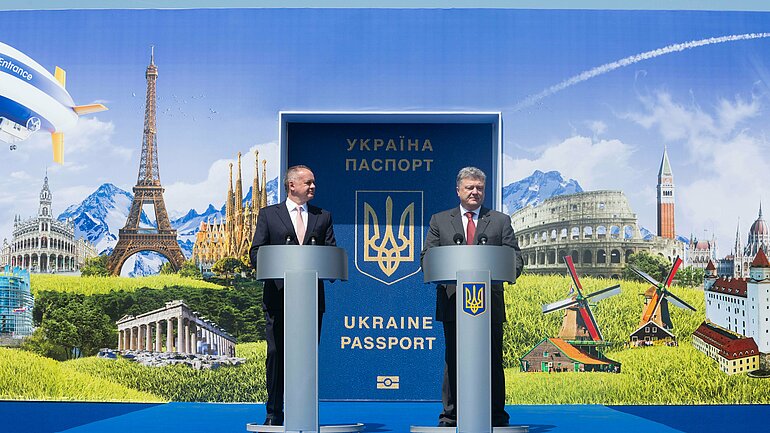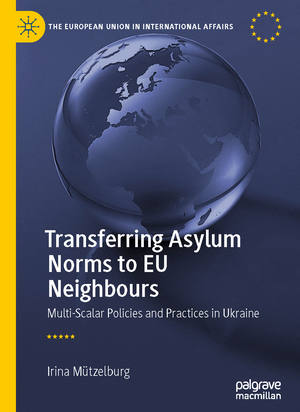'The EU is trying to establish asylum norms in non-EU countries so that there are fewer refugees living in the EU itself.'

In “Transferring Asylum Norms to EU Neighbours”, political scientist Irina Mützelburg explores the adoption and implementation of asylum norms by Ukraine over the last 30 years. In this interview, she explains the ambivalence and specificities of this process.
How much of a role does the issue of migration and displacement play in political discourse in Ukraine?
At a time when millions of people have been displaced within and out of Ukraine since February 2022, the political discourse around displacement and migration has of course changed considerably. However, my book focuses mainly on the time before the Russian invasion and looks at how Ukraine itself has dealt with asylum-seekers from other countries of origin, such as Afghanistan and Syria. In the three decades following Ukraine’s independence in 1991 until 2021, displacement and immigration barely featured in the public debate. Overall, it was not a highly politicised issue in Ukraine. This was mainly due to the relatively low number of asylum-seekers who fled to Ukraine with the intention of staying there.
In your book, you investigate the transfer of asylum norms. What exactly are asylum norms?
In a formal sense, asylum norms are the collection of national and international laws dealing with asylum and displacement. The United Nations High Commissioner for Refugees (UNHCR) has played a major role in producing these texts. The key international document forming the legal basis of asylum norms is the 1951 Geneva Convention on Refugees, which, among other things, defines who has a right to asylum, sets out the obligations of host countries, and lays down specific principles relating to the protection of refugees, including the principle of non-refoulement, which means that refugees may not be sent back to their country of origin or deported to a third country where their safety is at risk.
However, my book does not only deal with formalised asylum norms. In examining the concept of asylum norms, I also look at some of the principles governing the workings of government agencies – in other words, rules that are followed by the authorities and the courts in their processing of asylum cases. And I examine some of the common assumptions about legitimate or illegitimate conduct by asylum-seekers and refugees.

One of the findings of your research is that the European Union is attempting to establish specific asylum norms in third countries. What is the underlying strategy here, and how does it relate to the EU’s increasing efforts to close itself off to asylum-seekers?
The EU is trying to establish asylum norms in non-EU countries so that there are fewer asylum-seekers and refugees living in the EU itself. Extending the reach of asylum norms to third countries is a means of externalising EU asylum policy; the long-term objective is to ensure that people who have been displaced are taken in and offered protection by other countries outside the EU. There are two underlying aspirations here: first, that asylum-seekers will stay in the transit country where they are offered protection, rather than attempting to continue their journey into the EU – an expectation which may not necessarily come true. And second, by entering the EU from a designated safe third country where they have remained for a longer period of time, an asylum-seeker may be returned to that country legally, according to EU law. Of course, that is a very attractive option for EU countries that are attempting to reduce the number of refugees on their territories. This has not happened yet in the case of Ukraine, but we can see this approach still being applied in relation to other countries.
What are the benefits for third countries if they align themselves with the EU’s asylum norms?
In many cases, third countries do not see any benefits in adopting international asylum norms. Alignment with EU asylum norms is also viewed critically at the domestic level in some cases. We see this in the debates that took place in the Ukrainian Parliament in the 1990s. Some of the critics argued that instead of striving for partnership-based cooperation, the EU was mainly concerned with asserting its own agenda and was dismissing the interests and agency of countries such as Ukraine. There was a sense that Ukraine was being exploited by the EU as a kind of “buffer zone” for people who were unwelcome in the EU.
For some time now, however, the EU has been using incentives and conditionality in an attempt to encourage neighbouring countries to adopt and implement asylum norms. In the case of Ukraine, the EU incentive related to the abolition of the visa requirement, which played a very significant role from 2010 onwards. In order to bring about the abolition of the visa requirement for Ukrainians, which had applied since 2004 also for Poland, Slovakia and Hungary, the Ukrainian government had to fulfil a whole range of benchmarks, including the adoption of international asylum laws, both legally and in practice. For Ukrainian politicians, a visa-free regime for Ukrainians in the EU was a very attractive incentive and its introduction in 2016 proved very popular with the Ukrainian public. It was thanks to this visa-free regime that Ukrainian refugees were able to cross the border into the EU quickly and fairly easily in 2022 and remain in the EU for an initial period of three months as tourists before registering for temporary protection status.
Your book thus offers a critical analysis of relations between the EU and Ukraine. What does the Russian invasion mean for this analysis?
My book was finished, more or less, before the beginning of the large-scale Russian invasion. However, many of the issues addressed are still highly relevant. For example, my research clearly reveals the wide power gap and the dependencies which existed between the EU and Ukraine, and it shows how the EU exploits its position of power through its external relations in order to assert its own interests in the area of migration control. In terms of an academically sound critique of European migration policy, this is no less relevant now than before the war. Unfortunately, there is a risk that any depiction of Ukraine’s dependencies on the EU will be exploited for Russian propaganda purposes, given that some of Russia’s propaganda aims to depict Ukraine as a puppet of the EU. But this is a very misleading and dangerous notion, for despite the power inequalities in EU-Ukrainian relations, since its independence, Ukraine has become a state with its own agency and leeway. My book shows how a wide range of actors in Ukraine, from MPs to NGO and administrative staff, all pursue their own interests and beliefs and how this influences asylum law and practices. Dependencies and power gaps between Ukraine and EU still exist, however, and I believe they should continue to be a subject of our research. And it is not only about relations between the EU and Ukraine. In my book, I analyse how more powerful and prosperous states, regional or international organisations are attempting to influence local practices in other, often less powerful states in various ways and at various levels and how this is dealt with by those states. These processes continue to be relevant in many regions of the world.
The interview was conducted by Felix Jehn, intern in the Communications department at ZOiS.
Dr Irina Mützelburg is a researcher at ZOiS.
Mützelburg, Irina. Transferring Asylum Norms to EU Neighbours. Multi-Scalar Policies and Practices in Ukraine. London: Palgrave Macmillan, 2022.